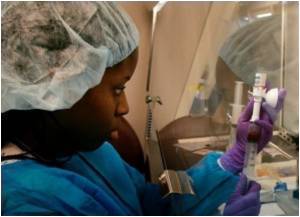Animal systems like fruit flies and sea anemones help investigate how epithelial cells maintain order while getting jostled by cell division, say researchers.

The study employs live imaging of fruit fly imaginal discs, simple larval tissues that ultimately give rise to the adult wing. “In a culture dish, cells can divide willy nilly,” says Gibson. “But in an organism cell division must be reconciled with the broader structural context. Our work is addressing how epithelial tissues maintain structural integrity, even during the extreme events of cell division.”
The starting point for this work was the lab’s 2011 Current Biology paper showing that when columnar cells packed in an epithelium divided, their upper (apical) end briefly ballooned out to allow the cell’s nucleus to move into that region. As division began, the mitotic spindle (which faithfully distributes chromosomes into each daughter cell) invariably oriented itself parallel to the apical surface of the epithelium.
In other words, if you pointed a tiny camera in your gut toward dividing epithelial cells of its lining, you would “see” the mitotic spindle looking like a symmetrical web, exactly like it did in your high school biology textbook.
To determine why its orientation was non-random, the group did an equivalent experiment. Using high resolution fluorescence imaging to look inside dividing cells in developing wing discs, they observed that the two poles of the spindle were always near the septate junctions, specific regions of close molecular contact between neighboring cells. Two junction components, proteins called Discs Large and Scribble, were juxtaposed to the spindle, suggesting they might act as cues to orient it.
The seemingly odd names given to these factors decades ago reflect what biologists saw in fly mutants lacking each protein. In flies without Discs Large, the imaginal discs are massively overgrown, while fly embryos lacking Scribble resemble a chaotic scribble reminiscent of a tumor. Gibson reasoned that the reported tumor-suppressive activity of these proteins might be linked to a role in keeping the mitotic spindle in line.
Advertisement
“I did not expect that spindle orientation defects could be sufficient to cause loss of epithelial identity,” explains Yu-ichiro Nakajima, Ph.D., a postdoctoral fellow in the Gibson lab and the study’s first author. “But people in the field have hypothesized that spindle misorientation might cause tumorigenesis or even contribute to cancer development.”
Advertisement
“The findings derived from epithelial biology often lead to a better understanding of cancer development,” says Nakajima. “We have found that spindle orientation has a tumor-suppressive role in proliferating epithelia. So we are looking for other spindle regulators that may represent novel tumor suppressors.”
Human epithelial cells do express mammalian Scribble and Discs Large proteins, and both play key roles in maintaining epithelial cell polarity, or shap—a property lost in metastatic cancer cells. Whether Scribble or Discs Large act as tumor suppressors in human cancers is under investigation.
Gibson urges caution in comparing regulation of Drosophila and human epithelia. Nonetheless he notes that normal tissues in both flies and humans protect themselves by killing off misbehaving cells via apoptosis. If that mechanism failed, as is frequently observed in human cancers, disordered cells within an epithelium could escape.
“When cells are basically imprisoned in an epithelial layer, things stay nicely organized,” says Gibson. “But in this study we found that simply forcing a cell to delaminate from an epithelium is enough to initiate an abnormal gene expression program. That means that maintaining an ordered structure is not just a physical requirement but could also protects cells from switching on potentially aberrant genes.” Other contributors were Emily Meyer from the Gibson lab, and Amanda Kroesen and Sean McKinney, Ph.D., from the Stowers Microscopy Center. The study was funded by the Stowers Institute for Medical Research and the Burroughs Wellcome Fund.
Source-Newswise









